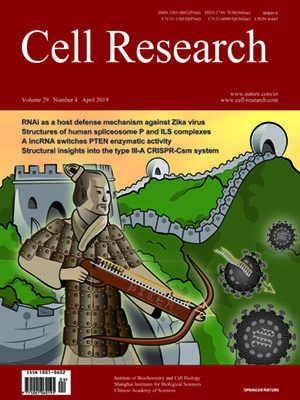
Volume 29, No 4, Apr 2019
ISSN: 1001-0602
EISSN: 1748-7838 2018
impact factor 17.848*
(Clarivate Analytics, 2019)
Volume 29 Issue 4, April 2019: 286-304
ORIGINAL ARTICLES
LncRNAs-directed PTEN enzymatic switch governs epithelial–mesenchymal transition
Qingsong Hu 1, Chunlai Li 1, Shouyu Wang 1,2, Yajuan Li 1, Bo Wen 3,4, Yanyan Zhang 1,10, Ke Liang 1, Jun Yao 1, Youqiong Ye 5, Heidi Hsiao 1, Tina K. Nguyen 1, Peter K. Park 1, Sergey D. Egranov 1, David H. Hawke 6, Jeffrey R. Marks 7, Leng Han 5, Mien-Chie Hung 1,8, Bing Zhang 3,4, Chunru Lin 1,8 and Liuqing Yang 1,8,9
1Department of Molecular and Cellular Oncology, The University of Texas MD Anderson Cancer Center, Houston, TX 77030, USA; 2Department of hepatobiliary Surgery, The Affiliated Drum Tower Hospital of Nanjing University Medical School, Nanjing, Jiangsu Province, China; 3Department of Molecular and Human Genetics, Baylor College of Medicine, Houston, TX 77030, USA; 4Lester and Sue Smith Breast Center, Baylor College of Medicine, Houston, TX 77030, USA; 5Department of Biochemistry and Molecular Biology, The University of Texas Health Science Center at Houston McGroven Medical School, Houston, TX 77030, USA; 6Department of Systems Biology, The University of Texas MD Anderson Cancer Center, Houston, TX 77030, USA; 7Department of Surgery, Duke University School of Medicine, Durham, NC 27710, USA; 8Program in Cancer Biology,Graduate School of Biomedical Sciences, The University of Texas MD Anderson Cancer Center, Houston, TX 77030, USA and 9Center for RNA Interference and Non-Coding RNAs,
The University of Texas MD Anderson Cancer Center, Houston, TX 77030, USA 10 Present address: Institute of Immunology, Third Military Medical University, 400038 Chongqing, China
Correspondence: Chunru Lin (clin2@mdanderson.org) or Liuqing Yang (lyang7@mdanderson.org)These authors contributed equally: Qingsong Hu, Chunlai Li, Shouyu Wang, Yajuan Li.
Despite the structural conservation of PTEN with dual-specificity phosphatases, there have been no reports regarding the regulatory mechanisms that underlie this potential dual-phosphatase activity. Here, we report that K27-linked polyubiquitination of PTEN at lysines 66 and 80 switches its phosphoinositide/protein tyrosine phosphatase activity to protein serine/threonine phosphatase activity. Mechanistically, high glucose, TGF-β, CTGF, SHH, and IL-6 induce the expression of a long non-coding RNA, GAEA (Glucose Aroused for EMT Activation), which associates with an RNA-binding E3 ligase, MEX3C, and enhances its enzymatic activity, leading to the K27-linked polyubiquitination of PTEN. The MEX3C-catalyzed PTENK27-polyUb activates its protein serine/threonine phosphatase activity and inhibits its phosphatidylinositol/protein tyrosine phosphatase activity. With this altered enzymatic activity, PTENK27-polyUb dephosphorylates the phosphoserine/threonine residues of TWIST1, SNAI1, and YAP1, leading to accumulation of these master regulators of EMT. Animals with genetic inhibition of PTENK27-polyUb, by a single nucleotide mutation generated using CRISPR/Cas9 (PtenK80R/K80R), exhibit inhibition of EMT markers during mammary gland morphogenesis in pregnancy/lactation and during cutaneous wound healing processes. Our findings illustrate an unexpected paradigm in which the lncRNA-dependent switch in PTEN protein serine/threonine phosphatase activity is important for physiological homeostasis and disease development.
FULL TEXT | PDF
Browse 1336


